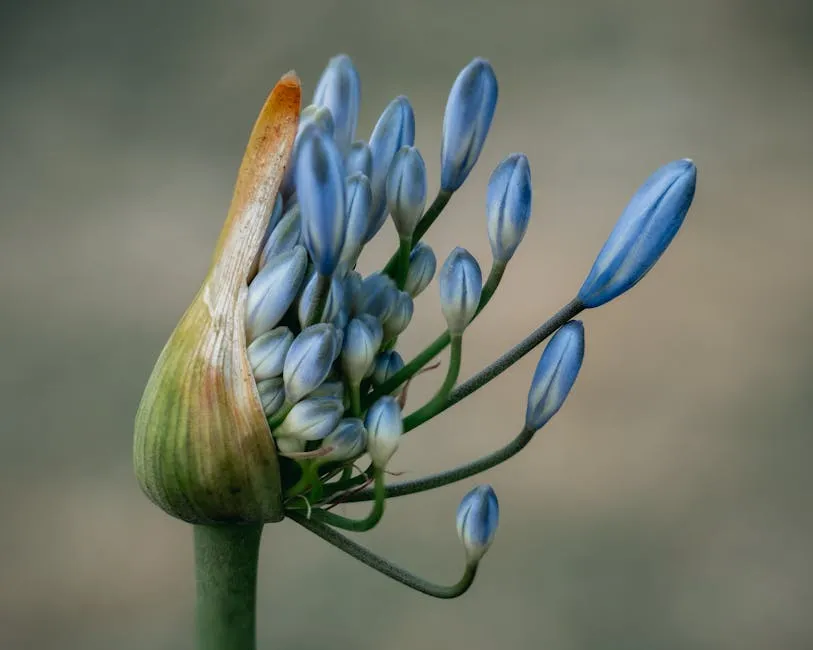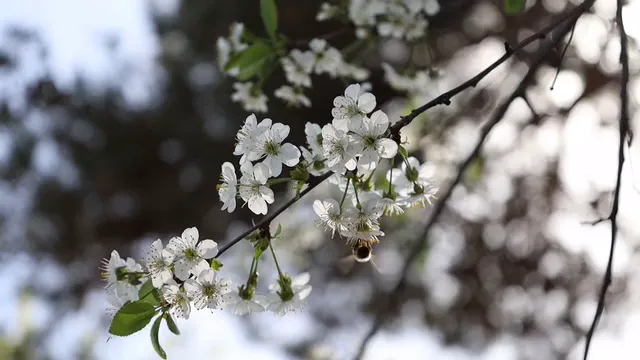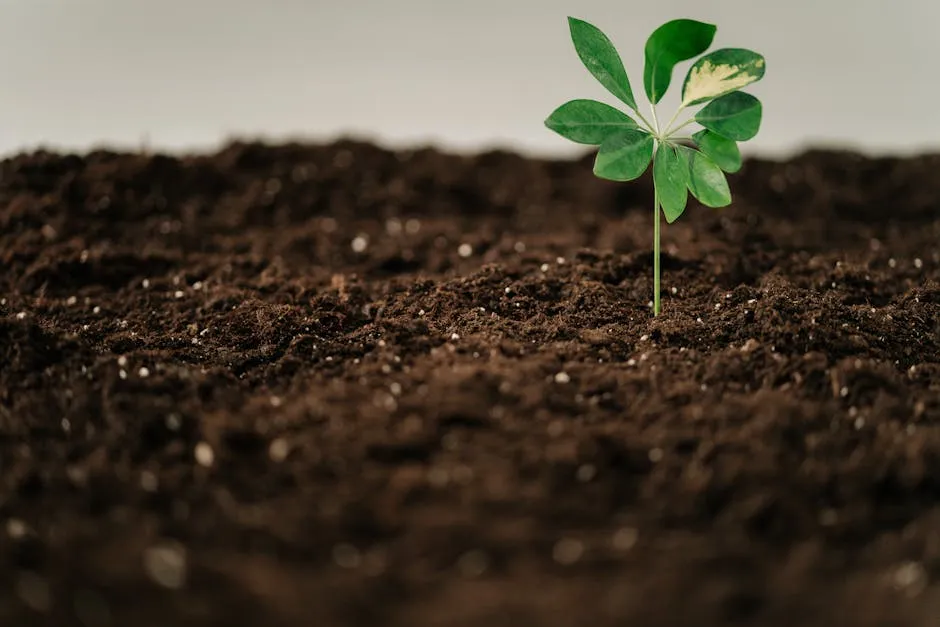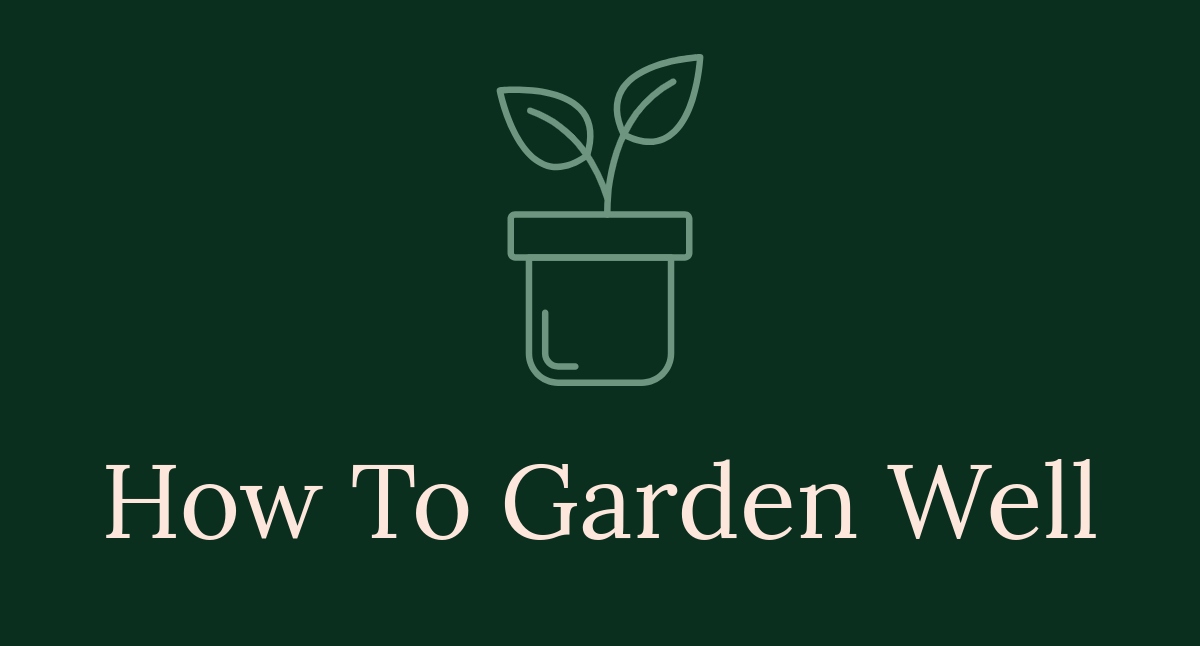

The Allure of the Blue Peter Pan Agapanthus Plant: A Gardener’s Dream
Preventative Measures:
- Healthy Soil: Ensure your soil drains well. Mix in organic matter for healthy roots.
- Water Wisely: Water at the base of the plant to keep leaves dry. This helps prevent fungal infections.
- Inspect Regularly: A quick check of your plants can catch any issues early. Look for signs of pests or disease weekly.
Treatments:
- Natural Predators: Encourage ladybugs and lacewings in your garden. They love feasting on aphids. Consider adding a Ladybug House for Garden to encourage these helpful insects.
- Neem Oil: This organic solution works wonders against pests. Spray it on affected areas to reduce infestations. Try using Neem Oil Spray for Plants for an effective treatment.
- Handpicking: For slugs and snails, simply collect them at night and relocate them far away.
With these tips, your Blue Peter Pan Agapanthus will remain a stunning star in your garden!

General Maintenance
Caring for your Blue Peter Pan Agapanthus is easier than pie—if pie were a delightful gardening task! Start by pruning your plant after the blooms have faded. This helps maintain its shape and encourages new growth. Cut back the stems to about 10 cm above the ground. This simple act prepares your plant for a glorious comeback next season.
Deadheading is another essential chore. Snip off those spent flowers to keep your plant looking neat. Plus, it helps the plant focus its energy on producing healthy foliage rather than forming seeds. It’s like giving your Agapanthus a little pep talk!
Seasonal care also plays a significant role. In spring, as the frost bids adieu, give your Blue Peter Pan a good drink! Water it well to kickstart growth. If you’re feeling fancy, a balanced fertilizer can give your plant a boost. Just remember, moderation is key—too much fertilizer can lead to leggy growth.
During summer, keep the watering consistent. These beauties like their soil to remain moist but not soggy. If you live in a particularly hot area, don’t be shy about giving them a little extra TLC. Consider using a Watering Can with Long Spout for precise watering.
As autumn rolls around, it’s time to prepare your Agapanthus for its winter slumber. Reduce watering and apply a layer of mulch around the base. This cozy blanket protects the roots from frost while conserving moisture. Don’t forget to use Organic Garden Soil Mix to enrich your garden bed.
With these straightforward maintenance tips, your Blue Peter Pan Agapanthus will continue to thrive and charm. Now, go forth and garden like a pro!

Conclusion
In conclusion, the Blue Peter Pan Agapanthus plant is not just a visual delight; it brings a unique charm and vibrancy to gardens of all sizes. With its manageable care requirements and stunning blooms, it stands as a testament to the beauty of perennial plants. Whether you’re looking to enhance your garden’s appeal or attract pollinators, this plant offers countless possibilities.
Imagine stepping into your garden and being greeted by a sea of vibrant blue flowers. The Blue Peter Pan Agapanthus creates a stunning focal point, drawing the eyes of passersby and pollinators alike. Its compact size makes it perfect for small spaces, while its clump-forming habit adds structure to any landscape design.
Moreover, this perennial is a low-maintenance superstar. As discussed, it thrives in various conditions, requiring just a bit of pruning and deadheading to keep it looking its best. With its hardiness, it can withstand the whims of changing seasons, making it an excellent choice for gardeners everywhere.
Don’t miss the chance to introduce this captivating perennial into your landscape, and watch it transform your outdoor space into a flower-filled sanctuary. As the seasons change, your Blue Peter Pan Agapanthus will continue to surprise you with its beauty and resilience, becoming a cherished part of your garden for years to come.
So, go ahead, plant it, nurture it, and bask in the joy it brings. You’ll soon find yourself enchanted by the elegance and charm of the Blue Peter Pan Agapanthus!
FAQs
Is the Blue Peter Pan Agapanthus hardy in all climates?
The Blue Peter Pan Agapanthus thrives best in USDA hardiness zones 7 to 11. While it can handle mild winters, extreme cold might pose a challenge. If you live in a frosty area, consider adding mulch for extra protection.
How do I propagate Blue Peter Pan Agapanthus?
Propagation can be done through division. In early spring or fall, carefully dig up the plant and separate the clumps. Ensure each division has roots and healthy shoots. Replant them in prepared soil, and watch them grow!
Can I grow Blue Peter Pan Agapanthus in pots?
Absolutely! Container gardening is a fantastic option for Blue Peter Pan. Choose a pot that’s at least 30 cm wide and deep. Ensure it has drainage holes and use well-draining soil. Remember to water regularly, especially during hot spells.
What should I do if my Agapanthus is not blooming?
If your plant isn’t blooming, check its sunlight exposure. It needs at least six hours of direct sunlight daily. Also, ensure you are not overfertilizing. Too much nitrogen can lead to lush foliage but fewer flowers. Adjust these factors, and you should see blossoms soon!
Please let us know what you think about our content by leaving a comment down below!
Thank you for reading till here 🙂
For more insights on how to grow plants in limited spaces, check out our guide on DIY vertical gardening ideas for apartments.
To ensure your plants stay healthy, you might want to explore natural remedies for common plant diseases.
For best results, familiarize yourself with best practices for watering container gardens.
If you’re interested in pruning techniques, check out our article on best practices for pruning fruit trees in winter.
All images from Pexels
Diseases to Watch For:
- Fungal Infections: Overwatering can lead to root rot and fungal issues. Keep an eye out for yellowing leaves or wilting.
- Leaf Spot: This is caused by fungal spores and manifests as dark spots on the leaves. If ignored, it can lead to premature leaf drop.
Preventative Measures:
- Healthy Soil: Ensure your soil drains well. Mix in organic matter for healthy roots.
- Water Wisely: Water at the base of the plant to keep leaves dry. This helps prevent fungal infections.
- Inspect Regularly: A quick check of your plants can catch any issues early. Look for signs of pests or disease weekly.
Treatments:
- Natural Predators: Encourage ladybugs and lacewings in your garden. They love feasting on aphids. Consider adding a Ladybug House for Garden to encourage these helpful insects.
- Neem Oil: This organic solution works wonders against pests. Spray it on affected areas to reduce infestations. Try using Neem Oil Spray for Plants for an effective treatment.
- Handpicking: For slugs and snails, simply collect them at night and relocate them far away.
With these tips, your Blue Peter Pan Agapanthus will remain a stunning star in your garden!

General Maintenance
Caring for your Blue Peter Pan Agapanthus is easier than pie—if pie were a delightful gardening task! Start by pruning your plant after the blooms have faded. This helps maintain its shape and encourages new growth. Cut back the stems to about 10 cm above the ground. This simple act prepares your plant for a glorious comeback next season.
Deadheading is another essential chore. Snip off those spent flowers to keep your plant looking neat. Plus, it helps the plant focus its energy on producing healthy foliage rather than forming seeds. It’s like giving your Agapanthus a little pep talk!
Seasonal care also plays a significant role. In spring, as the frost bids adieu, give your Blue Peter Pan a good drink! Water it well to kickstart growth. If you’re feeling fancy, a balanced fertilizer can give your plant a boost. Just remember, moderation is key—too much fertilizer can lead to leggy growth.
During summer, keep the watering consistent. These beauties like their soil to remain moist but not soggy. If you live in a particularly hot area, don’t be shy about giving them a little extra TLC. Consider using a Watering Can with Long Spout for precise watering.
As autumn rolls around, it’s time to prepare your Agapanthus for its winter slumber. Reduce watering and apply a layer of mulch around the base. This cozy blanket protects the roots from frost while conserving moisture. Don’t forget to use Organic Garden Soil Mix to enrich your garden bed.
With these straightforward maintenance tips, your Blue Peter Pan Agapanthus will continue to thrive and charm. Now, go forth and garden like a pro!

Conclusion
In conclusion, the Blue Peter Pan Agapanthus plant is not just a visual delight; it brings a unique charm and vibrancy to gardens of all sizes. With its manageable care requirements and stunning blooms, it stands as a testament to the beauty of perennial plants. Whether you’re looking to enhance your garden’s appeal or attract pollinators, this plant offers countless possibilities.
Imagine stepping into your garden and being greeted by a sea of vibrant blue flowers. The Blue Peter Pan Agapanthus creates a stunning focal point, drawing the eyes of passersby and pollinators alike. Its compact size makes it perfect for small spaces, while its clump-forming habit adds structure to any landscape design.
Moreover, this perennial is a low-maintenance superstar. As discussed, it thrives in various conditions, requiring just a bit of pruning and deadheading to keep it looking its best. With its hardiness, it can withstand the whims of changing seasons, making it an excellent choice for gardeners everywhere.
Don’t miss the chance to introduce this captivating perennial into your landscape, and watch it transform your outdoor space into a flower-filled sanctuary. As the seasons change, your Blue Peter Pan Agapanthus will continue to surprise you with its beauty and resilience, becoming a cherished part of your garden for years to come.
So, go ahead, plant it, nurture it, and bask in the joy it brings. You’ll soon find yourself enchanted by the elegance and charm of the Blue Peter Pan Agapanthus!
FAQs
Please let us know what you think about our content by leaving a comment down below!
Thank you for reading till here 🙂
For more insights on how to grow plants in limited spaces, check out our guide on DIY vertical gardening ideas for apartments.
To ensure your plants stay healthy, you might want to explore natural remedies for common plant diseases.
For best results, familiarize yourself with best practices for watering container gardens.
If you’re interested in pruning techniques, check out our article on best practices for pruning fruit trees in winter.
All images from Pexels
Common Pests:
- Aphids: These tiny green bugs love to munch on tender leaves. Look for curled or distorted foliage as a sign.
- Spider Mites: These microscopic critters thrive in dry conditions. If you see fine webbing on your plant, it’s time to take action.
- Snails and Slugs: These slimy guys can wreak havoc at night. They leave behind a telltale trail of destruction.
Diseases to Watch For:
- Fungal Infections: Overwatering can lead to root rot and fungal issues. Keep an eye out for yellowing leaves or wilting.
- Leaf Spot: This is caused by fungal spores and manifests as dark spots on the leaves. If ignored, it can lead to premature leaf drop.
Preventative Measures:
- Healthy Soil: Ensure your soil drains well. Mix in organic matter for healthy roots.
- Water Wisely: Water at the base of the plant to keep leaves dry. This helps prevent fungal infections.
- Inspect Regularly: A quick check of your plants can catch any issues early. Look for signs of pests or disease weekly.
Treatments:
- Natural Predators: Encourage ladybugs and lacewings in your garden. They love feasting on aphids. Consider adding a Ladybug House for Garden to encourage these helpful insects.
- Neem Oil: This organic solution works wonders against pests. Spray it on affected areas to reduce infestations. Try using Neem Oil Spray for Plants for an effective treatment.
- Handpicking: For slugs and snails, simply collect them at night and relocate them far away.
With these tips, your Blue Peter Pan Agapanthus will remain a stunning star in your garden!

General Maintenance
Caring for your Blue Peter Pan Agapanthus is easier than pie—if pie were a delightful gardening task! Start by pruning your plant after the blooms have faded. This helps maintain its shape and encourages new growth. Cut back the stems to about 10 cm above the ground. This simple act prepares your plant for a glorious comeback next season.
Deadheading is another essential chore. Snip off those spent flowers to keep your plant looking neat. Plus, it helps the plant focus its energy on producing healthy foliage rather than forming seeds. It’s like giving your Agapanthus a little pep talk!
Seasonal care also plays a significant role. In spring, as the frost bids adieu, give your Blue Peter Pan a good drink! Water it well to kickstart growth. If you’re feeling fancy, a balanced fertilizer can give your plant a boost. Just remember, moderation is key—too much fertilizer can lead to leggy growth.
During summer, keep the watering consistent. These beauties like their soil to remain moist but not soggy. If you live in a particularly hot area, don’t be shy about giving them a little extra TLC. Consider using a Watering Can with Long Spout for precise watering.
As autumn rolls around, it’s time to prepare your Agapanthus for its winter slumber. Reduce watering and apply a layer of mulch around the base. This cozy blanket protects the roots from frost while conserving moisture. Don’t forget to use Organic Garden Soil Mix to enrich your garden bed.
With these straightforward maintenance tips, your Blue Peter Pan Agapanthus will continue to thrive and charm. Now, go forth and garden like a pro!

Conclusion
In conclusion, the Blue Peter Pan Agapanthus plant is not just a visual delight; it brings a unique charm and vibrancy to gardens of all sizes. With its manageable care requirements and stunning blooms, it stands as a testament to the beauty of perennial plants. Whether you’re looking to enhance your garden’s appeal or attract pollinators, this plant offers countless possibilities.
Imagine stepping into your garden and being greeted by a sea of vibrant blue flowers. The Blue Peter Pan Agapanthus creates a stunning focal point, drawing the eyes of passersby and pollinators alike. Its compact size makes it perfect for small spaces, while its clump-forming habit adds structure to any landscape design.
Moreover, this perennial is a low-maintenance superstar. As discussed, it thrives in various conditions, requiring just a bit of pruning and deadheading to keep it looking its best. With its hardiness, it can withstand the whims of changing seasons, making it an excellent choice for gardeners everywhere.
Don’t miss the chance to introduce this captivating perennial into your landscape, and watch it transform your outdoor space into a flower-filled sanctuary. As the seasons change, your Blue Peter Pan Agapanthus will continue to surprise you with its beauty and resilience, becoming a cherished part of your garden for years to come.
So, go ahead, plant it, nurture it, and bask in the joy it brings. You’ll soon find yourself enchanted by the elegance and charm of the Blue Peter Pan Agapanthus!
FAQs
Please let us know what you think about our content by leaving a comment down below!
Thank you for reading till here 🙂
For more insights on how to grow plants in limited spaces, check out our guide on DIY vertical gardening ideas for apartments.
To ensure your plants stay healthy, you might want to explore natural remedies for common plant diseases.
For best results, familiarize yourself with best practices for watering container gardens.
If you’re interested in pruning techniques, check out our article on best practices for pruning fruit trees in winter.
All images from Pexels
Introduction
In the world of gardening, few plants capture attention quite like the Blue Peter Pan Agapanthus. This stunning perennial flaunts vibrant blue flowers that can brighten up any garden bed, making it a true showstopper. Its clump-forming habit adds structure and elegance to your landscape, while its ability to thrive in various conditions makes it a go-to choice for gardeners of all skill levels.
But what truly sets the Blue Peter Pan Agapanthus apart? It’s not just about the looks, but also the charm and versatility it brings. Whether you’re sprucing up a sunny border or creating a lush oasis, this plant fits right in.
Let’s consider its origins. The Blue Peter Pan Agapanthus belongs to the Amaryllidaceae family. It’s not native to the UK or Ireland, but it has certainly made itself at home here. This non-native status doesn’t deter its popularity; instead, it adds an exotic flair to gardens.
Care for this beauty is relatively straightforward. With some basic guidelines, even novice gardeners can help it flourish. Imagine stepping into your garden and being greeted by clusters of funnel-shaped flowers, dancing in the breeze.
In this article, we’ll explore the Blue Peter Pan Agapanthus in detail. We’ll cover its unique characteristics, care tips, and the irresistible charm it contributes to any outdoor space. Get ready to discover why this plant deserves a prized spot in your garden and how it can transform your outdoor space into a floral paradise. Whether you’re looking to enhance your garden aesthetics or attract pollinators, this perennial is just the ticket!

Summary
The Blue Peter Pan Agapanthus plant is a stunning addition to any garden, known for its striking blue flowers and clump-forming growth habit. In this comprehensive guide, we will explore the plant’s family, native status, and foliage type. We will also touch on its safety information, as all parts of the plant can be potentially harmful if ingested.
Key Points to Spark Curiosity:
- Origins and Family: Learn about the Amaryllidaceae family and the plant’s non-native status to the UK and Ireland.
- Growth Characteristics: Discover why this deciduous plant is favored for its clump-forming nature and how it can enhance garden aesthetics.
- Flower Description: Find out what makes its funnel-shaped flowers so visually appealing and how they contribute to attracting pollinators.
- Care Tips: Get expert advice on how to cultivate and care for the Blue Peter Pan Agapanthus to ensure it thrives in your garden.
- Potential Risks: Understand the safety precautions to take, especially if you have pets or children.
By the end of this article, you will not only have a comprehensive understanding of the Blue Peter Pan Agapanthus but also the confidence to integrate it into your gardening repertoire.

The Fascinating World of Agapanthus
History and Origins of Agapanthus
Agapanthus, often called African lily, has a rich history. Native to South Africa, this plant has graced gardens worldwide since the 17th century. Initially, it was prized for its striking flowers and resilience. Gardeners adored its ability to thrive in various climates, making it a favorite in temperate regions.
In many cultures, Agapanthus symbolizes love and fertility. Ancient Egyptians revered it, associating it with the Nile’s beauty. Fast forward to today, and its popularity endures. In Europe and North America, it’s a staple in gardens, often featured in ornamental landscapes. The Blue Peter Pan variety stands out, known for its compact size and vibrant blue blooms.
This plant has also found a place in contemporary garden design. Its versatility allows it to complement various styles, from modern to traditional. Whether as a border plant or in mass plantings, Agapanthus brings elegance and charm.

Characteristics of the Blue Peter Pan
The Blue Peter Pan Agapanthus is a true gem among its relatives. This perennial features striking, funnel-shaped blue flowers that bloom on tall stems. These blooms create a captivating display from midsummer through early autumn. The plant’s clump-forming habit adds structure, making it ideal for borders or containers.
Compared to other Agapanthus varieties, Blue Peter Pan is compact. It typically reaches heights of 30 to 60 cm, making it perfect for smaller gardens. Its foliage consists of narrow, strap-like leaves that provide a lush backdrop for the vibrant flowers.
While other varieties may produce white or purple blooms, Blue Peter Pan consistently showcases its stunning blue petals. This unique color draws in pollinators, making it a great choice for eco-friendly gardens. Its hardiness and adaptability set it apart, allowing it to thrive in various conditions, from coastal areas to urban settings.

Growing Blue Peter Pan Agapanthus
Ideal Growing Conditions
To flourish, Blue Peter Pan Agapanthus requires specific growing conditions. Start with well-draining soil that retains some moisture. Sandy loam is ideal, as it prevents waterlogging while supporting healthy growth. A pH level between 6.0 and 7.0 is optimal. Using an excellent Soil pH Test Kit can help you monitor and adjust your soil’s acidity for optimal growth.
Sunlight is crucial for this plant’s success. Aim for full sun, which means at least six hours of direct sunlight daily. However, it can tolerate partial shade, especially in hotter climates.
When it comes to climate, Blue Peter Pan thrives in USDA hardiness zones 7 to 11. It can endure mild winters but may struggle in extreme cold. For regions with frost, consider mulching around the base to protect roots. Consider using Mulch for Garden Beds to help retain moisture and regulate soil temperature.
Planting depth is important. Aim to plant the rhizomes about 10 to 15 cm deep, ensuring the crown sits at soil level. For spacing, allow 30 to 45 cm between plants. This spacing promotes air circulation, reducing the risk of disease.

Watering and Fertilization
Watering is key for Blue Peter Pan Agapanthus, especially during its growing season. Aim for consistent moisture without oversaturating the soil. Water deeply once a week, adjusting frequency based on rainfall and temperature.
Fertilization supports healthy growth and vibrant blooms. Use a balanced, Slow-Release Fertilizer in spring as new growth emerges. A formula with equal parts nitrogen, phosphorus, and potassium works well.
As seasons change, adjust your care routine. In summer, increase watering if the weather is particularly hot. In fall, reduce watering as the plant prepares for dormancy. Avoid fertilizing in late fall and winter to prevent new growth that can be damaged by cold.
With these practices, your Blue Peter Pan Agapanthus will thrive, offering stunning blooms and lush foliage. Happy gardening!

Pest and Disease Management
When it comes to the Blue Peter Pan Agapanthus, keeping it healthy is key. These plants can face a few pesky pests and diseases that could dampen their beauty.
Common Pests:
- Aphids: These tiny green bugs love to munch on tender leaves. Look for curled or distorted foliage as a sign.
- Spider Mites: These microscopic critters thrive in dry conditions. If you see fine webbing on your plant, it’s time to take action.
- Snails and Slugs: These slimy guys can wreak havoc at night. They leave behind a telltale trail of destruction.
Diseases to Watch For:
- Fungal Infections: Overwatering can lead to root rot and fungal issues. Keep an eye out for yellowing leaves or wilting.
- Leaf Spot: This is caused by fungal spores and manifests as dark spots on the leaves. If ignored, it can lead to premature leaf drop.
Preventative Measures:
- Healthy Soil: Ensure your soil drains well. Mix in organic matter for healthy roots.
- Water Wisely: Water at the base of the plant to keep leaves dry. This helps prevent fungal infections.
- Inspect Regularly: A quick check of your plants can catch any issues early. Look for signs of pests or disease weekly.
Treatments:
- Natural Predators: Encourage ladybugs and lacewings in your garden. They love feasting on aphids. Consider adding a Ladybug House for Garden to encourage these helpful insects.
- Neem Oil: This organic solution works wonders against pests. Spray it on affected areas to reduce infestations. Try using Neem Oil Spray for Plants for an effective treatment.
- Handpicking: For slugs and snails, simply collect them at night and relocate them far away.
With these tips, your Blue Peter Pan Agapanthus will remain a stunning star in your garden!

General Maintenance
Caring for your Blue Peter Pan Agapanthus is easier than pie—if pie were a delightful gardening task! Start by pruning your plant after the blooms have faded. This helps maintain its shape and encourages new growth. Cut back the stems to about 10 cm above the ground. This simple act prepares your plant for a glorious comeback next season.
Deadheading is another essential chore. Snip off those spent flowers to keep your plant looking neat. Plus, it helps the plant focus its energy on producing healthy foliage rather than forming seeds. It’s like giving your Agapanthus a little pep talk!
Seasonal care also plays a significant role. In spring, as the frost bids adieu, give your Blue Peter Pan a good drink! Water it well to kickstart growth. If you’re feeling fancy, a balanced fertilizer can give your plant a boost. Just remember, moderation is key—too much fertilizer can lead to leggy growth.
During summer, keep the watering consistent. These beauties like their soil to remain moist but not soggy. If you live in a particularly hot area, don’t be shy about giving them a little extra TLC. Consider using a Watering Can with Long Spout for precise watering.
As autumn rolls around, it’s time to prepare your Agapanthus for its winter slumber. Reduce watering and apply a layer of mulch around the base. This cozy blanket protects the roots from frost while conserving moisture. Don’t forget to use Organic Garden Soil Mix to enrich your garden bed.
With these straightforward maintenance tips, your Blue Peter Pan Agapanthus will continue to thrive and charm. Now, go forth and garden like a pro!

Conclusion
In conclusion, the Blue Peter Pan Agapanthus plant is not just a visual delight; it brings a unique charm and vibrancy to gardens of all sizes. With its manageable care requirements and stunning blooms, it stands as a testament to the beauty of perennial plants. Whether you’re looking to enhance your garden’s appeal or attract pollinators, this plant offers countless possibilities.
Imagine stepping into your garden and being greeted by a sea of vibrant blue flowers. The Blue Peter Pan Agapanthus creates a stunning focal point, drawing the eyes of passersby and pollinators alike. Its compact size makes it perfect for small spaces, while its clump-forming habit adds structure to any landscape design.
Moreover, this perennial is a low-maintenance superstar. As discussed, it thrives in various conditions, requiring just a bit of pruning and deadheading to keep it looking its best. With its hardiness, it can withstand the whims of changing seasons, making it an excellent choice for gardeners everywhere.
Don’t miss the chance to introduce this captivating perennial into your landscape, and watch it transform your outdoor space into a flower-filled sanctuary. As the seasons change, your Blue Peter Pan Agapanthus will continue to surprise you with its beauty and resilience, becoming a cherished part of your garden for years to come.
So, go ahead, plant it, nurture it, and bask in the joy it brings. You’ll soon find yourself enchanted by the elegance and charm of the Blue Peter Pan Agapanthus!
FAQs
Please let us know what you think about our content by leaving a comment down below!
Thank you for reading till here 🙂
For more insights on how to grow plants in limited spaces, check out our guide on DIY vertical gardening ideas for apartments.
To ensure your plants stay healthy, you might want to explore natural remedies for common plant diseases.
For best results, familiarize yourself with best practices for watering container gardens.
If you’re interested in pruning techniques, check out our article on best practices for pruning fruit trees in winter.
All images from Pexels



